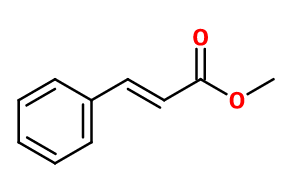
Photo credits: ScenTree SAS
| Company | Ingredient Name | ID | Comments | Naturality | Certifications | Purity | Latin name | Treated part | Geographical origin | MOQ |
|---|---|---|---|---|---|---|---|---|---|---|
|
|
Natural Methyl Cinnamate | AM-002 |
Visit website
|
Natural |



|
100 | Alpinia malaccensis | Root | Indonesia | 25 Kgs |
|
|
METHYL CINNAMATE | 21009 |
Visit website
|
Molecule | - | - | - | - | - |
General Presentation
-
CAS N° : 103-26-4
-
EINECS number : 203-093-8
-
FEMA number : 2698
-
FLAVIS number : Donnée indisponible.
-
JECFA number : Donnée indisponible.
-
Appearance : White crystals
-
Density : 1,042
-
Volatility : Base
-
Price Range : €€
Physico-chemical properties
-
Molecular formula : C10H10O2
-
Molecular Weight : 162,19 g/mol
-
Log P : Donnée indisponible.
-
Fusion Point : 37°C
-
Boiling Point : 255°C
-
Detection Threshold : Donnée indisponible.
-
Optical rotation : Donnée indisponible
-
Vapor pressure : Donnée indisponible
-
Refractive Index @20°C : Donnée indisponible
-
Acid Value : Donnée indisponible.
-
Flash Point : 123°C
Uses
Uses in perfumery :
Methyl Cinnamate is used mainly to create oriental accords (vanilla, balsams, leather) or floral notes such as rose, carnation or hyacinth.
Year of discovery :
Data not available.
Natural availability :
Methyl Cinnamate is present in various plants, starting with plants of the genus Alpinia, from the zingibiraceae family (same family as ginger), of which it can represent up to 80% of the composition of the essential oil. It is also present at more than 50% in the essential oil of Ocimum canum, a plant of the lamiaceae family, looking like clary sage. Methyl Cinnamate can therefore be extracted from these raw materials.
Isomerism :
The double bond of Methyl Cinnamate gives rise to two possible diastereoisomers. Both have a relatively similar smell. The racemic mixture of the two isomers is generally used in perfumery.
Synthesis precursor :
Methyl Cinnamate is not a precursor to the synthesis of another compound of olfactory interest.
Synthesis route :
Methyl Cinnamate can be synthesized in two ways. The first is a conventional acidic esterification between Cinnamic Acid and methanol. The second is a Claisen condensation, that consists in reacting Benzaldehyde with Methyl acetate in the presence of sodium.
Regulations & IFRA
Allergens :
This ingredient does not contain any allergen.
IFRA 51th :
This ingredient is not restricted for the 51th amendment


